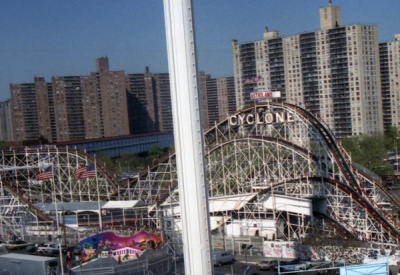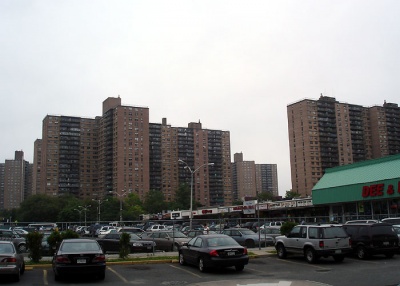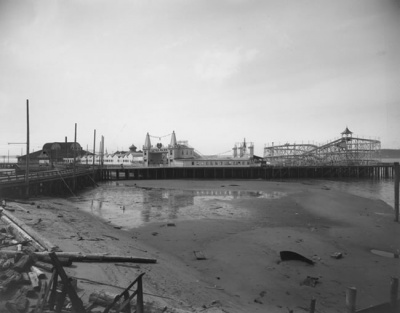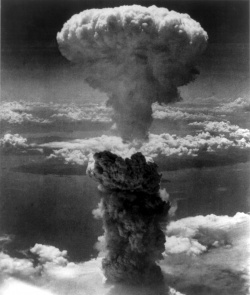Talk:Coney Island Turning PointsFrom The Peopling of New York City
Quick HistoryAfter World War I, the Treaty of Versailles left Germany with virtually no power and no land. After some years of silence, Germany, led by Adolf Hitler, began their quest for power once again. They began to conquer and acquire territories such as Austria, Sudetenland, and Czechoslovakia. Towards the beginning, France and Britain were reluctant to get involved with Germany's actions because they had no desire of entering war yet again. They turned a blind eye to Germany's bold advances. However, when Germany invaded Poland, France and Britain had no choice but to show force towards Germany in order to protect themselves. However, Hitler had took an extra careful step to sign a ten-year nonaggression pact with the Soviet Union, thus agreeing to split the land he were to conquer with the Soviets. This allowed Germany to invade Poland, and they took the western portion of the country and handed the east to their newfound allies. As preparations for war continued, Japan and Italy entered into alliances with Germany as well, giving the Axis Powers more power than France and Britain combined.[1] On April 9th, 1940, Germany defeated Denmark and then Norway. In order to reach the French, the German army would first need to cross three other countries, to which they enlisted the help of the Italian friends. After the loss of France to the dark side, the British tried their best to stand their ground. Even then, the United States refrained from entering war on the side of the Allied Powers. They were only keen to offer small bits of help, such as providing the British with weaponry through the passage of the Lend and Lease Act.[2] Unable to break through to the British, the Axis Powers diverted their attention to attacking and conquering smaller nations throughout Eastern Europe. As Japan advanced into mainland Asian territory, the U.S. stepped in slightly to protect their protectorate nation of the Philippines. In retaliation, on December 7th, 1941, the Japanese launched an attack on Pearl Harbor, which devastated the U.S. naval base stationed there. And as a result, the United States was left with no choice but to declare war on Japan to seek vengeance and justice. They had finally entered the war.[3] The turning point of the war came when the Allies won the Battle at Midway Island. Midway Island gave the Allies better access to winning victory over the Japanese. Germany, on the other hand, was forced to surrender shortly after the Allies invaded the beaches of Normandy and fought to reclaim France. With the reluctance to surrender, the United States resorted to using nuclear warfare to bring the war to a close. In 1945, two atomic bombs were unleashed upon Hiroshima and Nagasaki. As mushroom clouds filled the sky, Emperor Hirohito had no choice but to surrender to the Allies.[4] The devastation caused by the bombs and the lingering radiation left an imprint on global history. The use of nuclear warfare towards the end of WWII led to the panic and fear associated with the Cold War that shortly followed.
Introducing The ProblemWhen did Coney Island STOP being the summer destination spot for working class New Yorkers? Why? What caused such an illustrious and prominent community to decline in the first place? The answer? The advent of Public Housing in Post WW2 America Turning Points: The advent of Public HousingConey Island: Planning Nostalgic SpaceSource: homepage.mac.com/jjrivero/coney_island/text/introduction.pdf For a long time, Coney Island offered a large public forum which was available to almost all classes and ethnicities. Coney's main objective was providing temporary relief from extremely enduring 19th century social conventions. Coney Island allowed for the relaxation of social boundaries and provided people with a portal to escape reality. Like all good things, Coney's amusement parks eventually lost their glamour and led to the decline of all of Coney Island as a result. There are several socio-economic factors that can be held accountable for the gradual decline of Coney. The amusement parks managed to remain popular through much of the 40s, but could not hold off an inevitable decline. Economic conditions began to deteriorate in the 50s, and as a result, the city began to draw up plans devoting large sections of the neighborhoods to high density residential uses. As a result, plans for housing developments such as Luna Park, Trump Village, and Warbasse, among others, were drawn up by developers. One would think that the construction of new housing developments would help a struggling community. Concentrated pockets of poverty developed in these projects due to the low income families being brought in. Coney Island of the 60s and 70s would become known for its high levels of crime, arson, and racial unrest. The city's fiscal crisis at this time only made matters worse, causing the area to be neglected and forgotten. Public services and police presence in the community dropped greatly. Over time, people began looking for ways to get out of the area, and those who could leave did just that, leaving the poor behind. The 60s and 70s truly marked the decaying period of Coney Island, something that could have never been imagined during the glory years. Subdivision of the problem1961 NY Times Article: David BinderSource: "It's Not All Fun At Coney Island" 1961: New York Times  Luna Park Village http://www.stevespak.com/spak/pictures/cifromww.jpg  Trump Village http://excitingny.com/brooklynpics/trumpvillage.jpg Beginning during the post World War 2 years, the mind set of many people changed in and around Coney Island. A once prominent amusement area slowly began to deteriorate with many public officials becoming concerned over the "increasing shabbiness" of the area. As concerns throughout the country turned towards public housing and possible ways for sheltering the increasing population, the need to revitalize Coney's amusement parks seemed to take a back seat. According to Census Bureau figures from 1961, Coney Island experienced a population decrease from 81,816, to 74, 711 in 1957, to 72, 792 in 1960. Building and city planners began to devise ways to bring people back to the area, and as a result, created many proposals for construction of middle income housing developments. In 1961, at the time these proposals were being considered, Luna Park Village was one of the most interesting ideas. It consisted of five twenty story buildings which would be situated right where the once famous amusement park stood. Some of the other housing developments included one that was being put together by Frederick C. Trump and would rightfully be called Trump Village. This housing development would be bounded by Neptune Avenue, Ocean Parkway, and west 5th street. the third major development was proposed by a man named Peter Warbasse, and would be located adjacent to Trump Village. According to the article, demolition had already begun to clear the way for construction. These were not the only public housing projects being situated around Coney Island at the time. Other developments were being considered right on surf avenue, which was once the headquarters of many of the once popular amusement parks that gave Coney Island its fame. All of these developments would drastically change the face and attitude of Coney Island for many many years.
Caption: I found this article very interesting and useful because I live in one of these housing developments. I have lived in Warbasse for my entire life, and all my friends are from Trump Village and Luna Park. It's quite interesting to see from other articles how the proposals for these developments went through extremely long and difficult processes and at times almost never went through. The images included in this passage show three of the housing developments mentioned in this NY Times article. The uppermost image shows modern day Luna Park, located directly behind Astroland, which is entering its final season this summer. The second image shows Trump Village, the housing development which was put together by Frederick Trump, Donald Trump's father. The bottom image shows Warbasse, which is my apartment complex and was developed by Peter Warbasse as mentioned in the article above.
1964 NY Times Article: Martin TolchinSource: "Coney Island Slump Grows Worse" 1964: New York Times Coney Island's decline has steadily continued ever since the peak years of World War 2. In the summer of 1964, Coney experienced its worst season since 1937, which only suffered due to weather related issues. In 1964, concessionaires reported a business drop of 30 to 90 percent from the previous year. As an example, one can look at the actual amusement park rides and see obvious declines in their usage. The Wonder Wheel, which had 12,500 customers July 4, 1947, had just 4,174 patrons the previous memorial day. In 1963, the Wonder Wheel had attracted 10,000 people on average per weekend. In 1964, one year later, that number was down 3,000. The amusement park employees attributed the decline in business to many factors, including hoodlums, racial tension, inadequate parking, and public housing. Many Concessionaires blamed the growing number of negro visitors to the area for why many white customers may have been reluctant to visit as they normally would have. Also, teenage gangs had grown to be very popular in the area at the time and they were always causing mischief in and around the amusement parks. Inadequate parking could also be a reason why numbers were declining, but this implied a much larger reason. Many of the private parking lots had been replaced by the large housing developments in the area mentioned in the previous article over the previous decade. As a result, the area became much more condensed and could have turned many travelers away. By the looks of it, the public housing projects that were intended to benefit the area, were only creating a larger rift between the old Coney and what was quickly becoming the new. Amusement Parks of New York: Jim FutrellSource: Amusement Parks of New York: Jim Futrell  Whats left of Luna Park after the fire http://anita64.files.wordpress.com/2007/06/luna_01.jpg In 1944, a fire broke out in Luna Park and destroyed almost half of the park. This fire marked the end of Luna Park's prosperity, with more fires in 1946 and 1948 completely putting the park to ruins. By this time, the land that Luna Park once occupied was sold to developers with plans of building a housing complex there, which would eventually be named Luna Park Village. This housing complex opened in the late 1950s. Luna Park's destruction and purchase was just the first of many signs that Coney Island was entering a place of no return. Businesses around the area began to struggle due to less visitors to the area, and more and more chunks of land were being sold to housing developers with the hopes of building several apartment complexes for middle class families. All of this helped contribute to the decline of Coney's amusement era. In 1953, the land that Dreamland once stood was sold, and in 1957, the New York Aquarium was built in its place. By this time, Steeplechase was the last remaining amusement park in the area. In 1964, as mentioned in an article from the NY Times listed above, was by far the worst season in Coney's history, when it reported drops of up to 90 percent. What were some possible reasons for this drop? Well, increasing crime in the area most definitely contributed, and with the creation of housing developments throughout the area, parking became very limited. By the end of 1964, Steeplechase closed, leaving Astroland (which opened in 1961 to reinvent the area) as the only amusement park in Coney Island. By the 1970s, Coney was broke due to lack of business. Crime had become a major issue in the area, and the once joyous streets and boardwalk were slowly deteriorating due to lack of interest by the city. Coney's time seem to have come to an end. |
